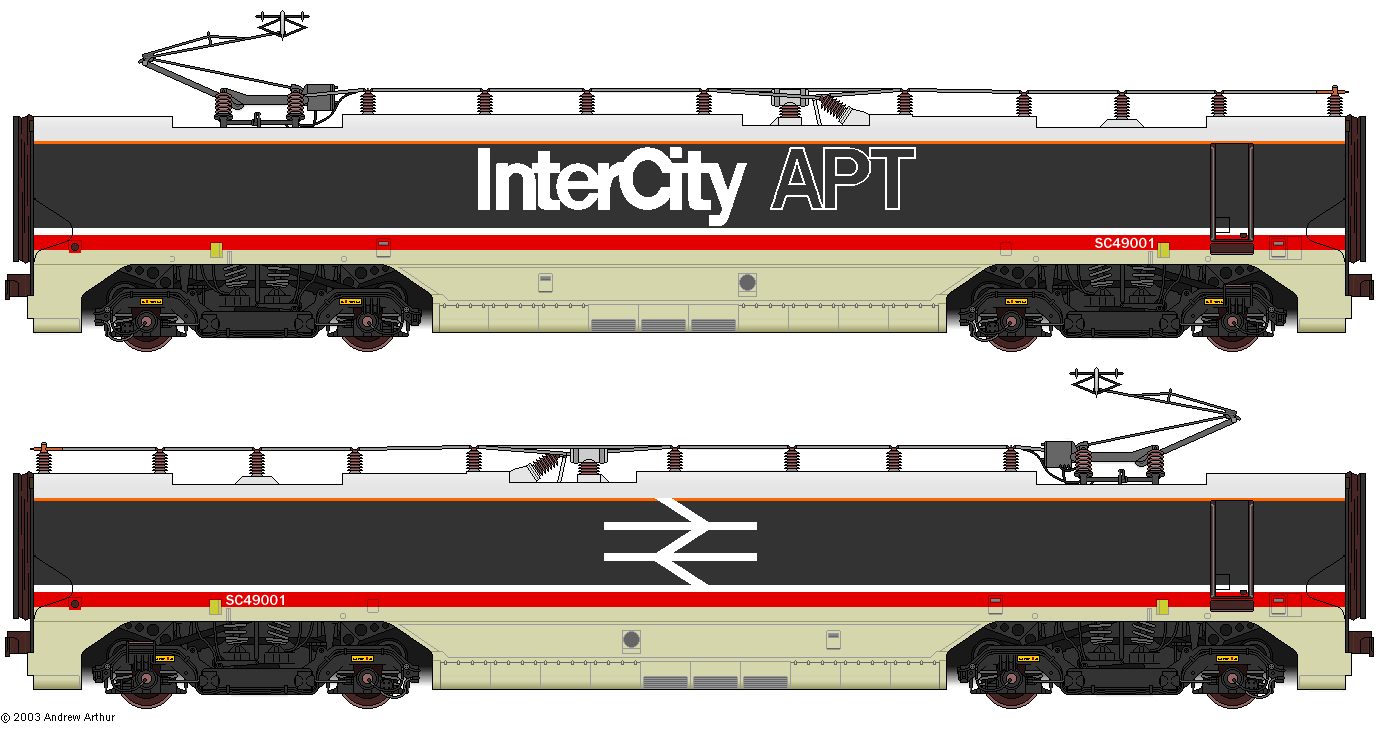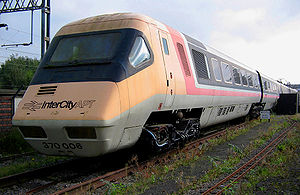
British Rail Class 370
Encyclopedia


British Rail
British Railways , which from 1965 traded as British Rail, was the operator of most of the rail transport in Great Britain between 1948 and 1997. It was formed from the nationalisation of the "Big Four" British railway companies and lasted until the gradual privatisation of British Rail, in stages...
's Class 370 tilting train
Tilting train
A tilting train is a train that has a mechanism enabling increased speed on regular rail tracks. As a train rounds a curve at speed, objects inside the train experience centrifugal force. This can cause packages to slide about or seated passengers to feel squashed by the outboard armrest due to...
s, also referred to as APT-P (meaning Advanced Passenger Train Prototype), were the pre-production Advanced Passenger Train
Advanced Passenger Train
The Advanced Passenger Train was an experimental tilting High Speed Train developed by British Rail during the 1970s and early 1980s....
units. Unlike the earlier experimental gas-turbine APT-E
British Rail APT-E
The APT-E, for Advanced Passenger Train Experimental, was the prototype Advanced Passenger Train tilting train unit. It was powered by gas turbines, the only multiple unit so powered that was used by British Rail. The APT-E consisted of two driving power cars and two trailer cars...
unit, these units were powered by 25kV AC overhead electrification
Overhead lines
Overhead lines or overhead wires are used to transmit electrical energy to trams, trolleybuses or trains at a distance from the energy supply point...
and were used on the West Coast Main Line
West Coast Main Line
The West Coast Main Line is the busiest mixed-traffic railway route in Britain, being the country's most important rail backbone in terms of population served. Fast, long-distance inter-city passenger services are provided between London, the West Midlands, the North West, North Wales and the...
between London Euston
Euston tube station
Euston tube station is a London Underground station served by the Victoria Line and both branches of the Northern Line. It directly connects with the Euston mainline station above it. The station is in Travelcard Zone 1....
and Glasgow Central. The APT-P is the most powerful domestic train to have operated in Britain, the eight traction motors fitted to the two central Motor Cars giving a total output of 8000 hp. This enabled the train to set the UK rail speed record of 162.2 miles per hour (261 km/h) in December 1979, a record that stood for 23 years.
Due to ongoing technical problems with these pre-production units, and a lack of cash or political will to take the project forward, the planned APT-S production-series units were never built, but did influence the design of the later InterCity 225
InterCity 225
The InterCity 225 is a locomotive-hauled domestic train in the United Kingdom, comprising a Class 91 electric locomotive, nine Mark 4 coaches and a Driving Van Trailer...
sets designed for the East Coast Main Line
East Coast Main Line
The East Coast Main Line is a long electrified high-speed railway link between London, Peterborough, Doncaster, Wakefield, Leeds, York, Darlington, Newcastle and Edinburgh...
electrification. The influence is strongest with the Class 91
British Rail Class 91
The British Rail Class 91 is a class of , electric locomotives ordered as a component of the East Coast Main Line modernisation and electrification programme of the late 1980s. The Class 91s were given the auxiliary name of InterCity 225 to indicate their envisaged top speed of...
locos which took many features from the APT powercars. The technology was later sold to Fiat and used for improving their second generation Pendolino
Pendolino
Pendolino is an Italian family of tilting trains used in Italy, Spain, Portugal, Slovenia, Finland, Russian Federation, the Czech Republic, the United Kingdom, Slovakia, Switzerland, China and shortly in Romania and Poland...
trains which have been used worldwide, including the West Coast Main Line
West Coast Main Line
The West Coast Main Line is the busiest mixed-traffic railway route in Britain, being the country's most important rail backbone in terms of population served. Fast, long-distance inter-city passenger services are provided between London, the West Midlands, the North West, North Wales and the...
.
Numbering
Units were numbered 370001-370006 (plus a spare driving car labelled 370007) and were formed as follows:- 48101-48107 - Driving Trailer Second
- 48201-48206 - Trailer Second
- 48401-48406 - Trailer Restaurant Second Buffet
- 48301-48306 - Trailer Unclassified
- 48501-48506 - Trailer First
- 48601-48606 - Trailer Brake First
- 49001-49006 - Non-Driving Motor
A full train was made up of two units running back-to-back, with the two motor cars adjoining. The motor cars had no seating accommodation or through-gangway, so the two halves of the train were unconnected for passengers.
Withdrawal

- 49006 is a Non-Driving Motor Car, and is at the Electric Railway Museum, BagintonCoventry Railway CentreThe Electric Railway Museum is located in Warwickshire, south of Coventry city, outside Baginton, and near to Coventry Airport. The heritage railway centre was also known as "The Airfield Line" as the railway was built on the site of a greenfield...
, near Coventry on loan from the National Railway Museum. - Crewe Heritage Centre, a museum located next to Crewe stationCrewe railway stationCrewe railway station was completed in 1837 and is one of the most historic railway stations in the world. Built in fields near to Crewe Hall, it originally served the village of Crewe with a population of just 70 residents...
, has a rake of six cars formed into a single train:- 48103 - Driving Trailer Second
- 48404 - Trailer Restaurant Second Buffet
- 48603 - Trailer Brake First
- 49002 - Non-Driving Motor
- 48602 - Trailer Brake First
- 48106 - Driving Trailer Second
Literature
- APT-P: The Intercity Development Train Publisher: British Railways
- The Shape of Travel to Come Publisher: British Railways
- British Rail's Advanced Passenger Train Publisher: British Railways
- APT Course Notes Publisher: British Railways Scottish Region]

